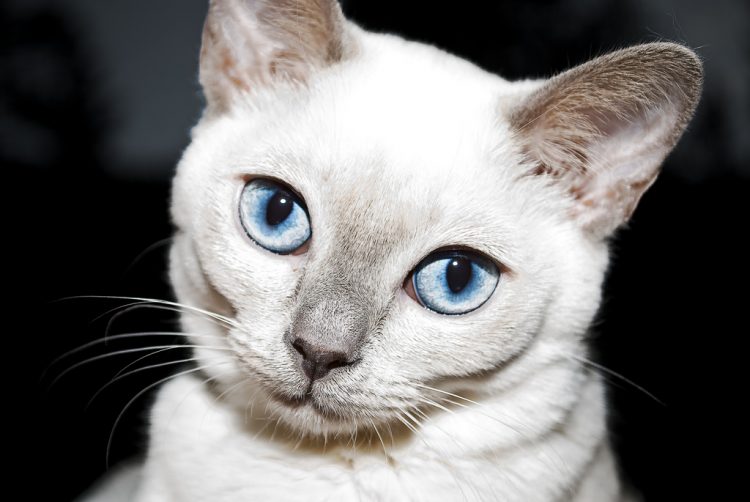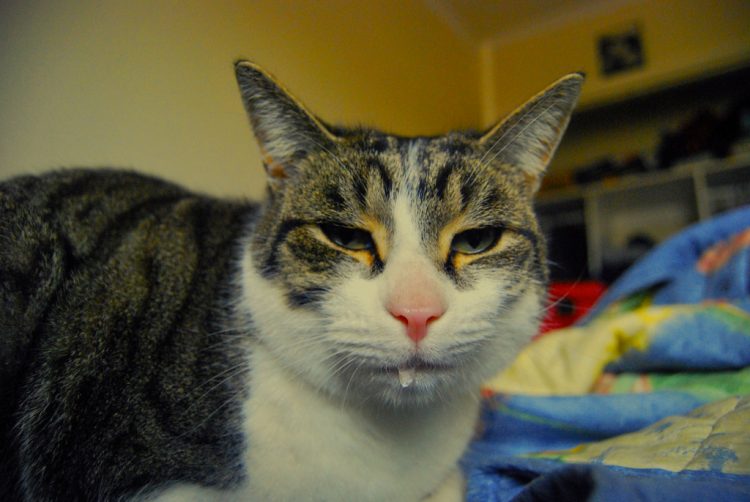[ad_1]
This pet health content about the dangers of a drooling cat was written by a veterinarian, Dr. Debora Lichtenberg, VMD. It was reviewed for accuracy by Dr. Pippa Elliott, BVMS, MRCVS, and was last updated October 14, 2025

Petful may earn a commission if you click on our links and make a purchase. This comes at no extra cost to you and helps us continue providing trusted pet product reviews.
Some cats drool when they are relaxed, purring, or enjoying a gentle petting session. A little drool now and then is perfectly normal and usually not a sign of illness.
However, a drooling cat that produces saliva continuously or in large amounts may be signaling an underlying health problem.
If your cat is drooling constantly, especially if she is older, it’s important to take this seriously and schedule a veterinary checkup right away.
- Occasional drooling is normal: Some cats drool when they are happy, relaxed, or being petted.
- Constant drooling is a warning sign: Continuous saliva production can signal dental disease, infection, or oral cancer.
- Older cats are more at risk: Persistent drooling in senior cats often points to serious health issues that need prompt attention.
- Early diagnosis improves outcomes: Detecting problems like oral squamous cell carcinoma early can extend quality of life.
- See your vet right away: If your cat drools excessively, has mouth odor, or struggles to eat, schedule a veterinary exam as soon as possible.
Don’t Guess When It Comes To Your Pet’s Care
Sign up for expert-backed reviews and safety alerts all in one place.




Don’t Guess When It Comes To Your Pet’s Care
Sign up for expert-backed reviews and safety alerts all in one place.
Oral Cancer in Cats
Feline oral squamous cell carcinoma is one of the most common and aggressive oral cancers in older cats. It often affects cats around 12 to 13 years old and can progress quickly if left untreated.
Here’s what you need to know about this serious condition:
- Highly aggressive: This cancer accounts for about 80% of oral tumors in cats.
- Affects senior cats most often: Older felines are particularly vulnerable to this disease.
- Drooling can be an early clue: A drooling cat may be showing the first sign of a tumor in the mouth.
Early detection offers the best chance for treatment and maintaining your cat’s comfort and quality of life. If you notice unusual drooling or mouth odor, contact your veterinarian as soon as possible.
Signs a Drooling Cat May Have Oral Cancer
Veterinarians often diagnose this cancer after owners notice subtle but serious changes in their cat’s behavior or eating habits.
Watch for these common warning signs:
- Unusual odor or constant drooling: Persistent saliva or foul breath can signal oral disease. Learn more about warning signs of cancer in cats and why cats develop bad breath.
- Difficulty chewing or eating on one side: Cats with tumors often drop food or appear hesitant to eat. While gingivitis and stomatitis can cause discomfort, tumors typically result in more severe pain.
- Bloody drool or swelling on the face: When drool becomes tinted with blood or swelling develops, the condition may already be advanced.
If your drooling cat shows any of these symptoms especially persistent saliva, mouth odor, or changes in eating behavior schedule a veterinary checkup as soon as possible.


How a Drooling Cat Is Diagnosed With Oral Cancer
Diagnosing oral cancer in cats can be challenging, especially when tumors develop under the tongue or deep within the mouth. Some cats may not tolerate a full exam while awake.
Here’s what veterinarians typically do during diagnosis:
- Physical exam and mouth inspection: Your vet will first look for visible growths, swelling, or inflammation inside the mouth.
- Sedation for a thorough check: If your cat resists an oral exam, light sedation or anesthesia may be required to inspect the area under the tongue safely.
- Blood work and imaging: Additional tests can help assess your cat’s overall health and confirm the presence of a tumor.
If your drooling cat becomes anxious during vet visits, read our guide on helping cats that are scared of the vet to make the experience less stressful.
Treatment Options for Feline Oral Cancer
Once a diagnosis is confirmed, time is critical. These tumors grow quickly and are often aggressive.
Treatment usually involves one or more of the following approaches:
- Surgery: If detected early, vets may attempt to remove the tumor with wide margins. However, cancers affecting the tongue or jaw can be difficult to remove completely.
- Radiation or chemotherapy: These therapies, often done with a veterinary oncologist, may improve comfort and extend life expectancy, though they are rarely curative.
- Palliative care: When surgery or chemo aren’t viable, pain management and supportive feeding are essential for maintaining comfort and quality of life.
For a deeper look at how these tumors behave and are managed, visit Cornell University’s overview of oral cavity tumors in cats
Learn more about this common disease in cats:
Prognosis and Quality of Life for a Drooling Cat With Oral Cancer
The outlook for cats diagnosed with oral squamous cell carcinoma is often poor, especially when the disease is found late. Many cats show advanced signs such as drooling, weight loss, or difficulty eating by the time they reach the vet.
Here’s what owners should understand about the prognosis:
- Limited survival time: Without treatment, life expectancy is usually one to two months. Even with surgery or radiation, many cats live around six months after diagnosis.
- Quality of life matters most: Cats in later stages often struggle to eat and may experience significant pain. Managing comfort becomes the main goal.
- Palliative options are available: Pain relief, liquid diets, and gentle care can keep your cat comfortable during this time.
If your drooling cat is facing late-stage oral cancer, speak honestly with your veterinarian about end-of-life care. You can learn more about planned euthanasia and the differences between hospice and euthanasia to make the most compassionate choice for your pet.
Recommended Products To Support A Drooling Cat
Used alongside veterinary care, these items can make diagnosis, treatment, and recovery easier. You can add your affiliate links to the product names below.
Note: Always ask your veterinarian which oral products are safe for your cat’s specific condition.
If your cat drools constantly, refuses food, or has bad breath, schedule a vet visit right away. Early diagnosis and treatment can make a major difference in your cat’s comfort and overall quality of life.
Caring for a Drooling Cat and Acting Early
A drooling cat might seem harmless, but constant drooling can point to hidden problems like dental disease or oral cancer. Paying attention to early signs and scheduling a vet visit right away can make a big difference in your cat’s comfort and long-term health.
With early detection, compassionate care, and your vet’s guidance, many cats can still enjoy a good quality of life even when faced with serious illness.
Frequently Asked Questions (FAQ)
What does it mean if a cat is drooling?
Occasional drooling can be normal, but persistent drooling often signals dental disease, nausea, or an underlying health issue.
Should I be concerned if my cat is dribbling?
Yes, constant dribbling may indicate pain, infection, or oral cancer and should be checked by a veterinarian.
What does it mean when a cat drools while purring?
Some cats drool when they are deeply relaxed or happy, especially during petting or purring.
Why is there liquid dripping from my cat’s mouth?
Liquid dripping from the mouth can result from dental problems, mouth injuries, or nausea and requires a vet visit if it continues.
[ad_2]
